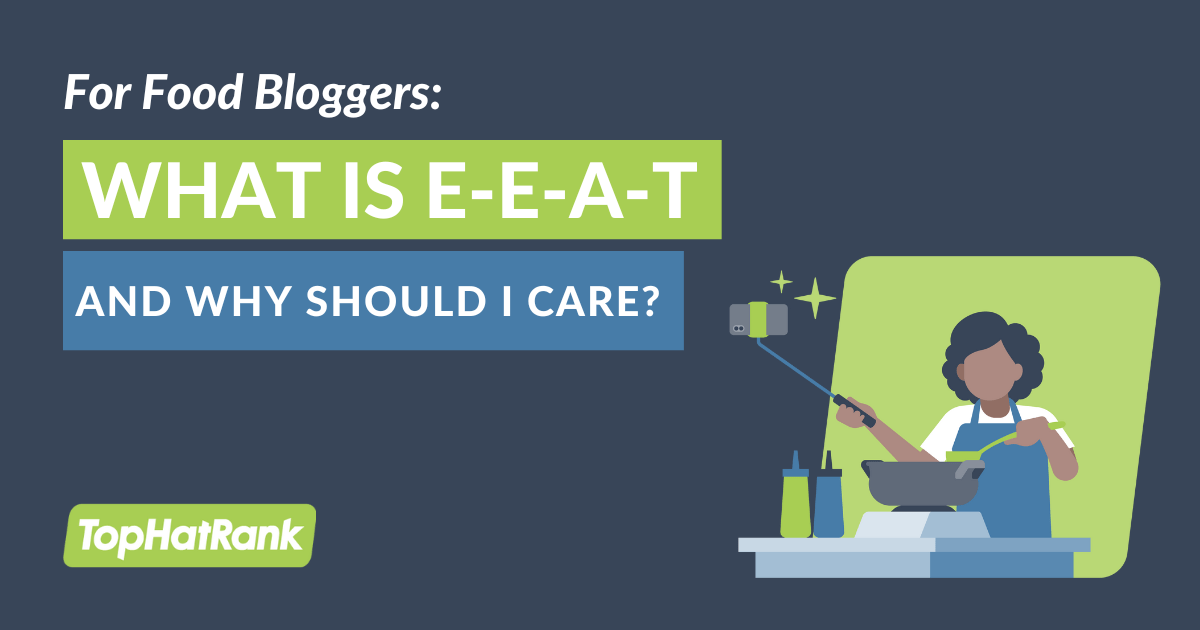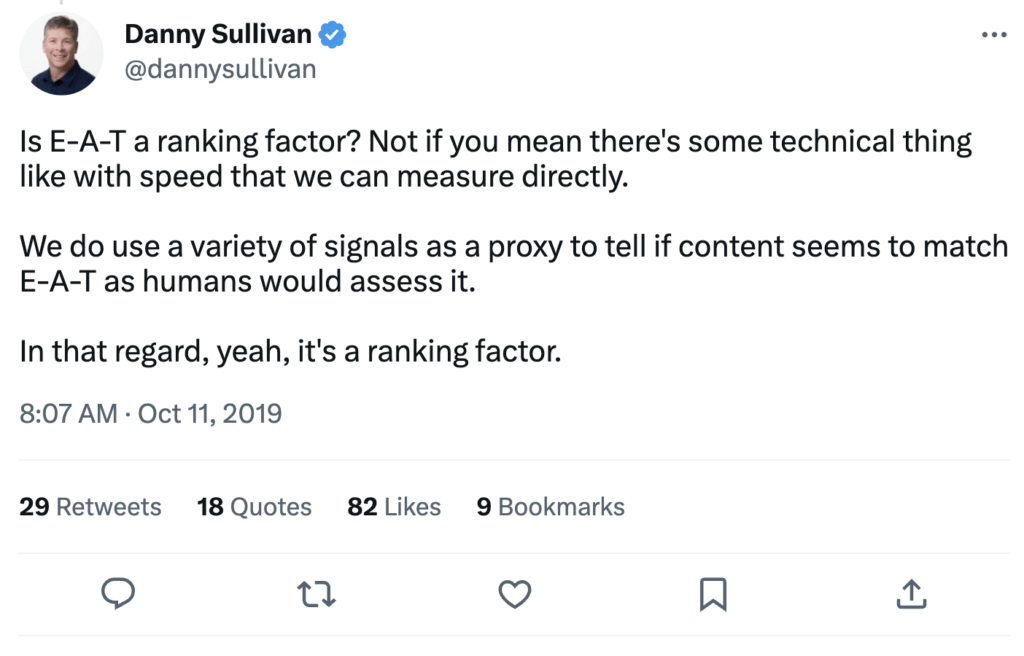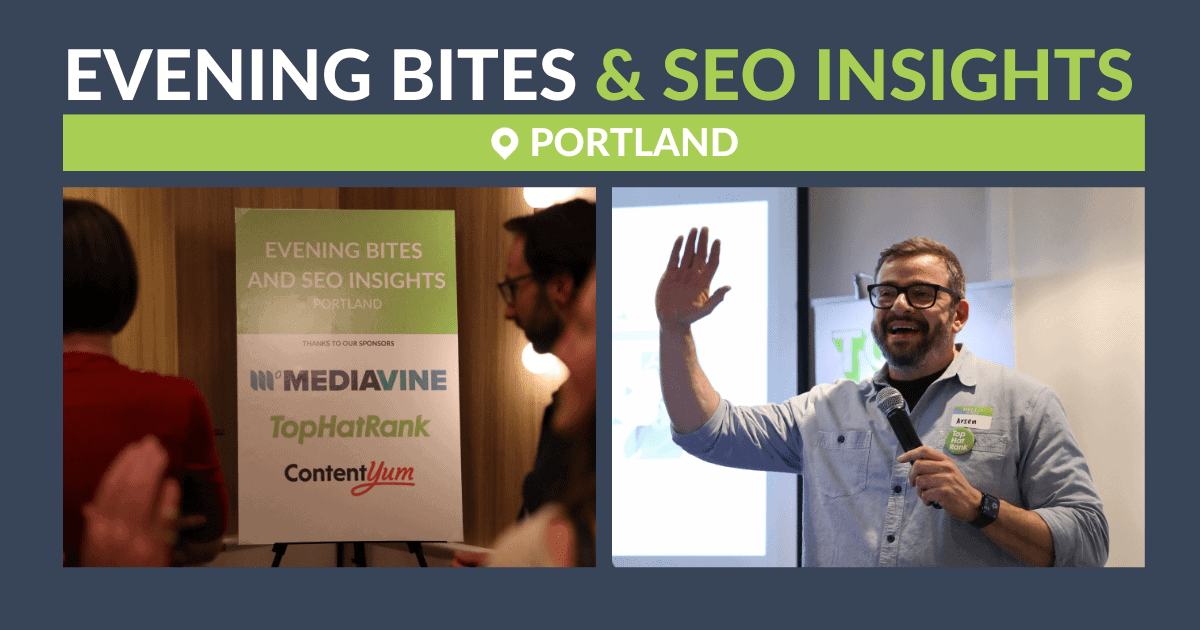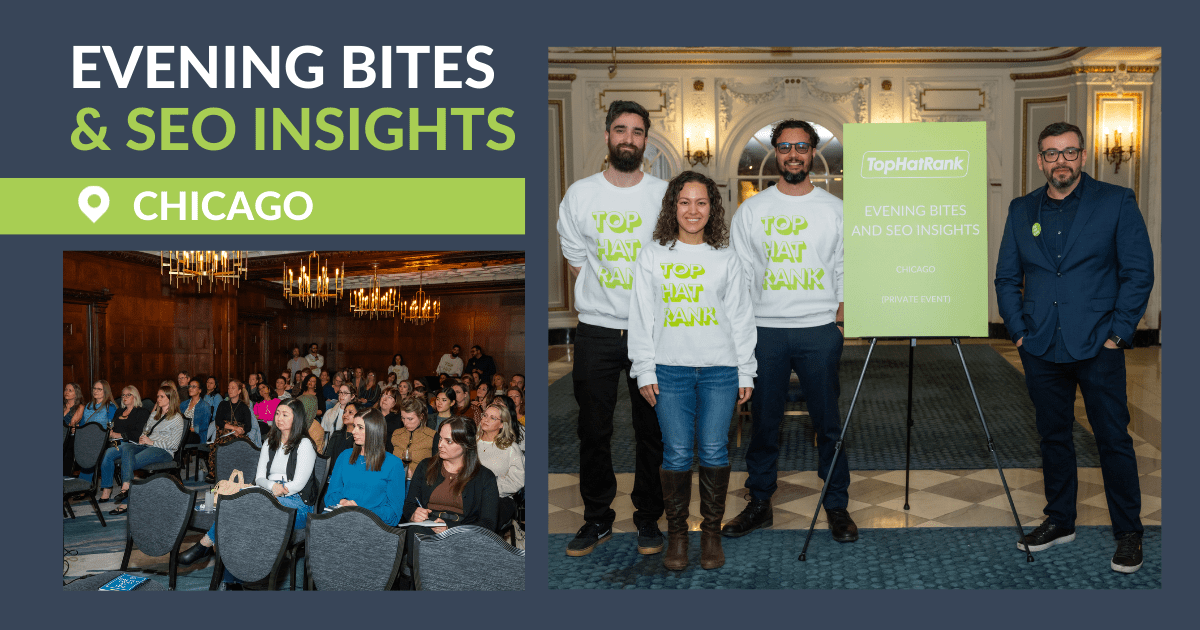For Food Bloggers: What Is E-E-A-T And Why Should I Care?

As a food blogger, you want to make sure that your readers have the best possible experience reading your content and engaging with your brand. To do this, one of the key elements you need to consider is E-E-A-T: an acronym that stands for Experience, Expertise, Authoritativeness, and Trustworthiness.
E-E-A-T stands at the core of Google’s Quality Rater Guidelines, which helps them determine if content is high quality or not. Although Google’s QRG is used by human quality raters, it is an important part of blogging because it is useful to see how Google might understand what a quality article is vs. a lower-quality article that’s not to be trusted.
This is important for food bloggers because this can help you identify how Google might assess the quality of a web page, and how to create better-quality web pages in Google’s eyes. Armed with this information, you will be better equipped to create content that satisfies this all-important acronym in Google’s bag of tricks.
What Is E-E-A-T?
In the beginning, Google’s Quality Raters Guidelines focused on E-A-T, or expertise, authoritativeness, and trustworthiness. This document became a beacon of sorts that showed how Google might handle certain types of content. It’s also updated on a semi-regular basis, at least several times a year. As a food blogger, you don’t have to become familiar with this entire guide (because it is incredibly lengthy and overwhelming), because that’s what we are here for: to take care of the hard work for you.
At its core, E-E-A-T focuses on four main aspects: experience, expertise, authoritativeness, and trustworthiness. While the acronym might sound funny, and make some folks hungry, it is a serious consideration when you are writing your blog posts. Understanding and embracing E-E-A-T can help you create content that is both useful and unique.
Experience speaks to your background knowledge and understanding of the topics that you write about. Expertise focuses on how well researched your article is, and if it stands up to the scrutiny of other experts in the field. Authoritativeness looks at how you are presenting your arguments and ideas, making sure that they carry weight and authority. Finally, trustworthiness deals with the reputation of your content; it is about showing readers that your blog post is accurate, reliable, and up-to-date.
Why Do We Care About E-E-A-T?
Google has established on numerous occasions that they do not use E-E-A-T within their algorithms, as explained by Google’s own Search Liaison, Danny Sullivan, below:
They do, however, utilize E-E-A-T within their Quality Raters Guidelines. This document is used by human quality raters at Google when they provide feedback on websites that they rate. Even though this is not a manual to achieving higher rankings algorithmically, it does provide some insight as to what Google might be considering when they are looking at sites that are successful vs. sites that are not successful. Including whether or not sites meet the threshold for determining a high quality site.
This is more of an empirical and arbitrary factor because of how it’s used, and should not be considered be-all, end-all advice as to whether your changes will directly impact your site’s organic search performance.
YMYL: Your Money Or Your Life And How This Plays Into E-E-A-T
Google clearly outlines in their Quality Raters Guidelines what YMYL topics are and how they play into E-E-A-T. YMYL stands for “Your Money or Your Life”, topics that are deemed so important that they can impact somebody’s life, health, or money negatively. These include topics such as health and finances, where incorrect information could lead to serious harm or even death.
For food bloggers, this means taking extra care when posting content about food, recipes, nutrition and dieting. Even if you consider yourself an expert, you should always provide sources and clearly indicate when a post is simply your opinion. Furthermore, it’s important to remember that the information you present must be accurate and up-to-date. For recipes, it’s less important to provide a source, especially if you are the creator of that recipe. Some YMYL attributes for recipes are rated lower than for other website niches, such as health, because a high degree of factual information is not necessarily needed to create that recipe.
But, be careful. If you’re suggesting people add Tide Pods to their recipes to increase the sweetness of that recipe, you’ll be in for a bad time (not to mention legal hot water if somebody tries your suggestion).
Google defines YMYL topics as “topics that may significantly impact or harm one or more of the following:”
- “the person who is directly viewing or using the content
- other people who are affected by the person who viewed the content
- groups of people or society affected by the actions of people who viewed the content”
Google further clarifies this with:
“YMYL topics can directly and significantly impact people’s health, financial stability or safety, or the welfare or well-being of society, because of the following reasons:
- The topic itself is harmful or dangerous. For example, there is clear and present harm directly associated with topics related to self-harm, criminal acts, or violent extremism.
- The topic could cause harm if the content is not accurate and trustworthy. For example, mild inaccuracies or content from less reliable sources could significantly impact someone’s health, financial stability, or safety, or impact society, for topics like: symptoms of a heart attack, how to invest money, what to do if there is an earthquake, who can vote, or needed qualifications for obtaining a driver’s license.
To determine whether a topic is YMYL, assess the following types of harm that might occur:
- YMYL Health or Safety: Topics that could harm mental, physical, and emotional health, or any form of safety such as physical safety or safety online.
- Topics that could damage a person’s ability to support themselves and their families.
- YMYL Society: Topics that could negatively impact groups of people, issues of public interest, trust in public institutions, etc.
- YMYL Other: Topics that could hurt people or negatively impact welfare or well-being of society.”
The above is a section of Google’s Quality Raters Guidelines that detail YMYL topics, and why they might be something that’s important for food bloggers to pay attention to when writing their posts. In addition, it also gives us some clues we can use to help establish our own E-E-A-T signals on our blogs.
Why Do We Have To Care About E-E-A-T? Where Did That Extra “E” Come From?
Google’s latest update to the QRG includes the addition of a second “E” to the already well-known acronym: E-A-T. Now, as of December, 2022, it’s E-E-A-T. The new E stands for experience, in addition to Expertise, Authoritativeness, and Trustworthiness. While expertise was concerned about whether your content reflects well-known attributes known in most articles, experience is more of an indicator as to how much depth in terms of first-hand experience that a particular author might have on a specific topic.
With the new addition of this E as the reframing of “E-A-T,” Google has also stated that trust is a significant factor that weighs into how a piece of content may be evaluated. In fact, trust is the most important factor at the center of E-E-A-T. Google explains to their quality raters the following about Trust:
“Trust: Consider the extent to which the page is accurate, honest, safe, and reliable. The type and amount of Trust needed depends on the page, for example:
- Online stores need secure online payment systems and reliable customer service.
- Product reviews should be honest and written to help others make informed purchasing decisions (rather than solely to sell the product).
- Informational pages on clear YMYL topics must be accurate to prevent harm to people and society.
- Social media posts on non-YMYL topics may not need a high level of Trust, such as when the purpose of the post is to entertain its audience and the content of the post does not risk causing harm.”
So, for food bloggers who provide books for purchase on their websites who might not use Amazon, take note that you need to provide a secure and safe online payment system for your customers. For food bloggers who provide product reviews, these need to be “honest and written to help others” who may be making purchasing decisions based on your reviews (as opposed to creating reviews to sell products on your site).
These are just some examples and takeaways of Google’s QRG attributes you must be familiar with to create a high quality website.
With the addition of the second “E,” the rest of the important elements of Google’s QRG have taken a backseat in terms of importance, but it doesn’t dilute how important it is to create these website signals.
Google’s Quality Raters Guidelines state the following for each of these:
“Experience: Consider the extent to which the content creator has the necessary first-hand or life experience for the topic. Many types of pages are trustworthy and achieve their purpose well when created by people with a wealth of personal experience. For example, which would you trust: a product review from someone who has personally used the product or a “review” by someone who has not?
Expertise: Consider the extent to which the content creator has the necessary knowledge or skill for the topic. Different topics require different levels and types of expertise to be trustworthy. For example, which would you trust: home electrical rewiring advice from a skilled electrician or from an antique homes enthusiast who has no knowledge of electrical wiring?
Authoritativeness: Consider the extent to which the content creator or the website is known as a go-to source for the topic. While most topics do not have one official, Authoritative website or content creator, when they do, that website or content creator is often among the most reliable and trustworthy sources. For example, a local business profile page on social media may be the authoritative and trusted source for what is on sale now. The official government page for getting a passport is the unique, official, and authoritative source for passport renewal.”
Google elaborates about Trust with the following:
“Trust is the most important member of the E-E-A-T family because untrustworthy pages have low E-E-A-T no matter how Experienced, Expert, or Authoritative they may seem. For example, a financial scam is untrustworthy, even if the content creator is a highly experienced and expert scammer who is considered the go-to on running scams!”
This is why E-E-A-T is more important than ever before. In an increasingly competitive SEO field that works on eliminating spammers and low-quality sites, including E-E-A-T signals can help further increase the reliability and viability of your site in Google’s eyes.
How Do You Establish E-E-A-T- Signals On A Food Blog?
It might seem counterintuitive, right? You write a food blog. Not a medical journal. But, on the contrary, food blogs deal with nutritional information along with the health of your audience. Your audience reads your blog to get recipes that could potentially make them healthier (or worse), correct? Thus, this is why we need to work on establishing E-E-A-T signals on our blog.
For one thing, it helps add to our credibility as authors. For another, it helps increase the quality of our content. And yet another reason: it helps to make our content presentable to our audience.
But, it’s important to note here: E-E-A-T is part of what Google’s human quality raters do when they are rating websites and they provide feedback to Google about what their algorithms are doing. It’s not about manipulating your sites for higher ranking (although this can be a side benefit of providing these signals on your blog). This is the one thing that most people who spread E-E-A-T miss when talking about it. Although an important topic, it’s not something that can easily manipulate a site’s ranking.
First, Include Your Author Bio In The Sidebar
This is the first step to establishing your E-E-A-T signals. Your author bio should include information about you, including your qualifications and experience in the area of culinary, food preparation, nutrition, or any other topics related to food blogging that you have expertise in.
Include a link to an external page about yourself and links to any relevant external sources. This is especially important if you have any credentials that can help establish your authority or expertise in the field.
Create An Author About Page
This page should be separate from the author bio in your sidebar. The Author About Page is a chance to showcase your credentials, expertise and experience in a more detailed manner. Make sure that you include any awards or accolades that you have received in this area as well as links to external sources where you have been mentioned or referenced by other experts in the field.
Again, this page should be separate from your author bio in the sidebar, but it should link to it and vice-versa. This helps establish E-E-A-T signals by giving readers a chance to learn more about you in greater detail.
Create An About Page For Your Specific Website
This is a separate page that talks about your website, its purpose, expertise, authority, and why readers should trust your site as a leader on the topic. This page should discuss why your site stands out from all other food blogs, and also include information about any awards or accolades you have received that are relevant to the field.
This will help establish trust with readers by providing them with a source of reference they can look to when questioning specific topics. It also helps Google understand what kind of content to expect from your site, which further helps establish E-E-A-T signals.
Include Your Author Byline On All Your Posts, And Link It To Your About Page (Not Author Page)
When you include your byline (the line that says By: Author Name) in your post, you want to make sure that you link it to your about page. This helps establish trust with readers and search engines. It also serves as a source of reference for readers when they are questioning the accuracy of your content.
Your about page refers to the detailed about page that you created that talks all about you and yourself. Not your author archive page. The author archive page is entirely different and should not be used for this interlinking activity.
For one thing, it will dilute your page’s topical authority, because you’re linking to a typically blank page. In addition, you could also confuse Google by linking to an author page that doesn’t reflect what it might expect from the standard author page, as opposed to the author archive page.
Include An Overview Of The Posts And Topics You Have Written About On Other Industry-Leading Authority Blogs
By having your content featured on other industry-leading authority blogs, it further helps establish E-E-A-T signals with both readers and search engines. It also helps to build trust with readers by showing that you are an established and respected expert in the field. Be sure to include a link back to your About page when adding a link to your posts.
It’s important to note here that we are not referring to guest blogging. Guest blogging is a low-quality, spammy tactic meant to build links quickly. And could potentially be frowned on by the search engines. Instead, we’re talking about establishing columns on higher authority food blogs that can then be linked back to your own blog in a high-quality manner.
This is the higher-quality form of guest blogging that isn’t considered spammy when done right and done well.
What Should Be On Your About Page?
There are five factors that help separate high-quality about pages from the rest:
There is a clear, high-quality photo of the author.
The about page talks about the author’s experience and expertise in their topic, rather than just a dull and boring life story.
There are clear accolades and distinctions that the author has been awarded thanks to their participation in a particular field. This is something that takes years to acquire, so don’t worry if you don’t have much in the way of these distinctions just yet.
These could be things like: “as featured on Jane’s Food Blog,” or “as featured on the Food Network blog.”
Any books the author has written, such as recipe books, cooking books, or anything that could help further establish real-world experience and expertise.
Any engagement objects such as podcasts, videos, and other types of media that helps provide even more detail and information about the author through things like interviews, guest appearances on other podcasts, and so on.
Anything else that might showcase an author’s influence and expertise within a specific industry.
By having a high-quality and detail-oriented About page, you can help establish E-E-A-T signals with readers and search engines alike. It’s important to use the above information as a guideline when creating your own About page so that it meets the standards set forth by Google in terms of demonstrating E-E-A-T signals. This can often be the difference between success and failure for food bloggers.
Creating Your Content Based On E-E-A-T Is Not An Exact Science…Or Art
Clearly, there are many factors in Google’s Quality Raters Guidelines to be sure. And you need to have a solid foundation in order to grasp what Google is doing for E-E-A-T and how they might identify low-quality content. Then you need to not DO that.
Don’t worry if this seems daunting at first. Getting it right takes time, but it’s time worth spending because it can help you differentiate your blog from those who are of low trust, low quality, and spammy. This is why it’s important to understand the basics of E-E-A-T, and how you can use them to your advantage when crafting content.
It’s also important to focus on creating high-quality, valuable content. Content that will make a lasting impression on readers, encouraging them to take an action such as signing up for your newsletter, or purchasing your product. Content that helps establish trust and credibility among readers by providing accurate, up-to-date information on your topic.
By following the guidelines in Google’s Quality Raters Guidelines and creating content based on E-E-A-T principles, you can help further increase your chances of success with food blogging. It will take some effort and time to get it right, but once you do, you can rest assured that your blog is well on its way to long-term success.




